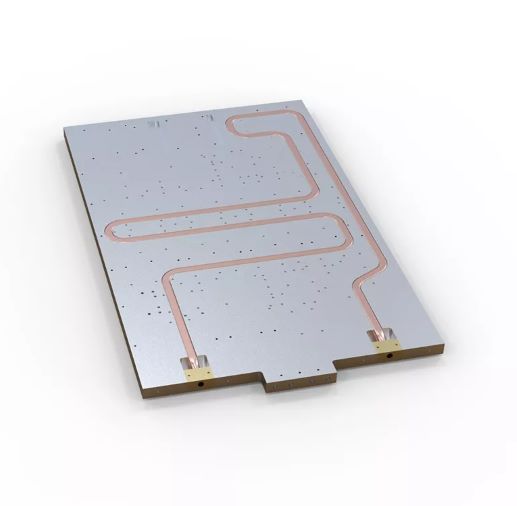62. The Working Principle Of Water Cooled Heat Sink
페이지 정보
작성자 최고관리자 작성일 22-09-15 17:37본문
Winshare and KCSONE Thermal shares with you the working principle of a water cold plate heat sink. Have you ever thought about how it works when using a water cold plate heat sink?
A typical water cooling system must have the following components: water cooling block, circulating fluid, water pump, pipes and water tank or heat exchanger. The water cooling block is a metal block with a water channel inside, made of copper or aluminum, which is in contact with the CPU and will absorb the heat of the CPU. The circulating fluid flows in the circulating pipeline by the action of a water pump. If the fluid is water, it is what we commonly call a water cooling system. The liquid that has absorbed the heat of the CPU will flow away from the water block on the CPU, and the new low-temperature circulating liquid will continue to absorb the heat of the CPU. The water pipe connects the water pump, the water cooling block and the water tank, and its function is to allow the circulating fluid to circulate in a closed channel without leakage, allowing the liquid cooling system to work normally. The water tank is used to store the circulating fluid. The heat exchanger is a device similar to a heat sink. The circulating fluid transfers heat to the heat sink with a large surface area, and the fan on the heat sink takes away the heat from the air flowing in.
Water cooling and air cooling are essentially the same, except that water cooling uses circulating fluid to transfer the heat of the CPU from the water cooling block to the heat exchanger and then dissipate it, instead of the homogeneous metal or heat pipe for air cooling. The heater part is almost a replica of the air-cooled heat sink. There are two characteristics of the water cooling system: balanced CPU heat and low noise operation. Due to the large specific heat capacity of water, it can absorb a large amount of heat without changing the temperature significantly. The temperature of the CPU in the water cooling system can be well controlled, and sudden operations will not cause instantaneous and large changes in the internal temperature of the CPU. Due to the large surface area of the heat exchanger, only a low-speed fan is needed to dissipate heat. Therefore, water cooling is mostly matched with a low-speed fan. In addition, the working noise of the water pump is generally not very obvious. In this way, the overall heat dissipation system is very quiet compared with the air-cooled system.
Water-cooling, an expensive and complicated heat sink, is a powerful and operable heat sink for PCs (liquid nitrogen and other cooling methods cannot be put into practical use). Overclockers with a spirit of exploration have already started using it a few years ago. To create a record of overclocking limit, the product itself has also changed from an early self-made model to a professional manufacturer's design and finalized mass production, and entered retail channels for sales. With the expansion of production scale and the gradual accumulation of design and manufacturing experience, we have been able to purchase relatively cheap water-cooled heat sinks. Their value will no longer be what they thought they were at the beginning or even exceed the sum of the user’s CPU and motherboard prices, and apart from the price In addition to the temptation, the humanized design of newer water-cooled heat sink products has also made considerable progress. Various reasons have contributed to the situation that water-cooled heat sinks can now enter the chassis of ordinary DIY players.
A typical water cooling system must have the following components: water cooling block, circulating fluid, water pump, pipes and water tank or heat exchanger. The water cooling block is a metal block with a water channel inside, made of copper or aluminum, which is in contact with the CPU and will absorb the heat of the CPU. The circulating fluid flows in the circulating pipeline by the action of a water pump. If the fluid is water, it is what we commonly call a water cooling system. The liquid that has absorbed the heat of the CPU will flow away from the water block on the CPU, and the new low-temperature circulating liquid will continue to absorb the heat of the CPU. The water pipe connects the water pump, the water cooling block and the water tank, and its function is to allow the circulating fluid to circulate in a closed channel without leakage, allowing the liquid cooling system to work normally. The water tank is used to store the circulating fluid. The heat exchanger is a device similar to a heat sink. The circulating fluid transfers heat to the heat sink with a large surface area, and the fan on the heat sink takes away the heat from the air flowing in.
Water cooling and air cooling are essentially the same, except that water cooling uses circulating fluid to transfer the heat of the CPU from the water cooling block to the heat exchanger and then dissipate it, instead of the homogeneous metal or heat pipe for air cooling. The heater part is almost a replica of the air-cooled heat sink. There are two characteristics of the water cooling system: balanced CPU heat and low noise operation. Due to the large specific heat capacity of water, it can absorb a large amount of heat without changing the temperature significantly. The temperature of the CPU in the water cooling system can be well controlled, and sudden operations will not cause instantaneous and large changes in the internal temperature of the CPU. Due to the large surface area of the heat exchanger, only a low-speed fan is needed to dissipate heat. Therefore, water cooling is mostly matched with a low-speed fan. In addition, the working noise of the water pump is generally not very obvious. In this way, the overall heat dissipation system is very quiet compared with the air-cooled system.
Water-cooling, an expensive and complicated heat sink, is a powerful and operable heat sink for PCs (liquid nitrogen and other cooling methods cannot be put into practical use). Overclockers with a spirit of exploration have already started using it a few years ago. To create a record of overclocking limit, the product itself has also changed from an early self-made model to a professional manufacturer's design and finalized mass production, and entered retail channels for sales. With the expansion of production scale and the gradual accumulation of design and manufacturing experience, we have been able to purchase relatively cheap water-cooled heat sinks. Their value will no longer be what they thought they were at the beginning or even exceed the sum of the user’s CPU and motherboard prices, and apart from the price In addition to the temptation, the humanized design of newer water-cooled heat sink products has also made considerable progress. Various reasons have contributed to the situation that water-cooled heat sinks can now enter the chassis of ordinary DIY players.
- 이전글63. The Extruded heat sink 22.11.18
- 다음글61. The Importance Of Heat Sink For Laser Equipment 22.09.15




